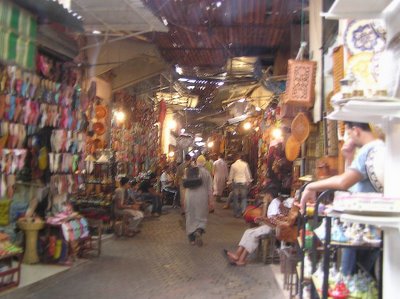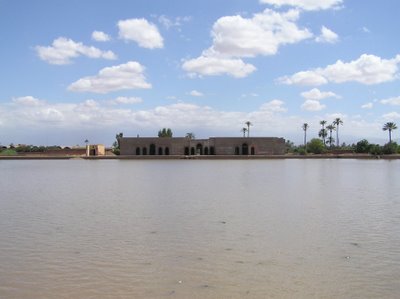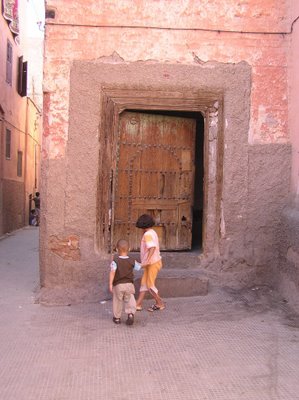Monday, September 25, 2006
Dance Chavez Dance
Here's an amusing video from Youtube.
It's a short propaganda film from Hugo Chavez, the president of Venezuela.
After you've enjoyed Chavez's warning to President Bush you can see him dancing and singing along to a backing band.
It's a short propaganda film from Hugo Chavez, the president of Venezuela.
After you've enjoyed Chavez's warning to President Bush you can see him dancing and singing along to a backing band.
Thursday, September 21, 2006
Rabat
Rabat is the capital of Morocco and the home of the king. It's markedly different to the rest of Morocco. There's none of the hassle of cities like Tangiers or Marrakesh. It seems that you don't muck around when you're in the kings city. Red and black pentagram flags fly everywhere and there is a strong police presence. There were almost no beggars, I didn't get offered drugs by shifty characters and the streets were very clean.
My hotel room overlooked a mosque and it was interesting to watch the men hurrying to the 3am prayers. I bought a nice Italian shirt in Rabat but was stupid enough to leave it hanging in the wardrobe. There was a TV in the room but the only English channel was CNN. I was completely wrapped in the story about the man confessing to the murder of Jon Benet Ramsey. I can't see how anyone took him seriously.
I've already mentioned Chellah but Rabat had a few other nice sites. The Mausoleum of Mohammed V also has the tomb of Hassan II inside. There is also the Hassan Tower which is a an incomplete mosque and minaret. It was meant to be 86m high but after the death of Yacoub al-Mansour in 1199 work stopped when the tower was only half completed. It was built with a ramp to the top instead of stairs so that the muezzin could ride a horse to the top.




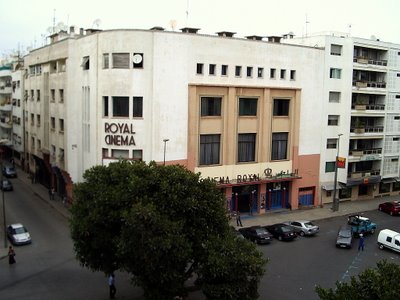


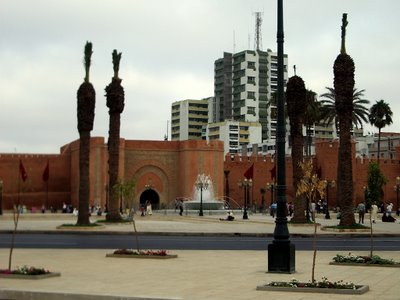
My hotel room overlooked a mosque and it was interesting to watch the men hurrying to the 3am prayers. I bought a nice Italian shirt in Rabat but was stupid enough to leave it hanging in the wardrobe. There was a TV in the room but the only English channel was CNN. I was completely wrapped in the story about the man confessing to the murder of Jon Benet Ramsey. I can't see how anyone took him seriously.
I've already mentioned Chellah but Rabat had a few other nice sites. The Mausoleum of Mohammed V also has the tomb of Hassan II inside. There is also the Hassan Tower which is a an incomplete mosque and minaret. It was meant to be 86m high but after the death of Yacoub al-Mansour in 1199 work stopped when the tower was only half completed. It was built with a ramp to the top instead of stairs so that the muezzin could ride a horse to the top.








Sunday, September 17, 2006
Eltham College
This weekend is the London Open House. It's an annual event where various public and private buildings of significance are opened to the public. I went to a huge 60s brutalist tower block not far from me. We were given a short talk about why it's interesting from an architectural point of view and then taken up to the 24th floor into someone's flat! The view was quite amazing and the apartment was a good example of how they managed to make the flats as roomy and well lit as possible in a small amount of space.
I also went to visit Eltham College in south-east London. Eltham College is the school where my father was educated before he moved to Australia. It was built in the 1700s and was a boys' boarding and day school. The boarding house was closed a few years ago and the school now allows girls to enroll for sixth form. I was shown the old school rooms in the main building and taken to the chapel by a prefect who freely admitted that she knew nothing about the school's history as she had only been there for three weeks.
The grounds were pretty typical public school with a couple of rugby pitches and a large number of horse-chestnut trees around the perimeter. The remains of vanquished conkers crunched under my feet. Some of you may be interested to know that the school library is named after Mervyn Peake, the author of the Gormenghast books and an old Elthamian.


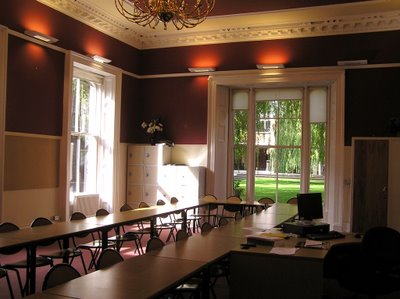




I also went to visit Eltham College in south-east London. Eltham College is the school where my father was educated before he moved to Australia. It was built in the 1700s and was a boys' boarding and day school. The boarding house was closed a few years ago and the school now allows girls to enroll for sixth form. I was shown the old school rooms in the main building and taken to the chapel by a prefect who freely admitted that she knew nothing about the school's history as she had only been there for three weeks.
The grounds were pretty typical public school with a couple of rugby pitches and a large number of horse-chestnut trees around the perimeter. The remains of vanquished conkers crunched under my feet. Some of you may be interested to know that the school library is named after Mervyn Peake, the author of the Gormenghast books and an old Elthamian.







Friday, September 15, 2006
Cake
I just thought that I would put up a link to this episode of Brasseye which discusses "cake".
Cake is a new drug on London streets. Ted Maul reports....
Here's a link to the BBC's Brasseye website.
Enjoy!
Cake is a new drug on London streets. Ted Maul reports....
Here's a link to the BBC's Brasseye website.
Enjoy!
Thursday, September 14, 2006
Chellah
Chellah is a World Heritage Site in Rabat, Morocco. In the first century AD, it was a Roman port until the collapse of the empire. The Merenids resettled Chellah in the 14th century and it was destroyed by an earthquake in the 18th. The site is a stunning mixture of Roman and medieval architecture. There is a medersa and two minarets right next to Roman marble columns and a necropolis. All for only 20 dirham (£1.20) it's cheaper than the taxi to get there.
Just as we were leaving, a bus load of French tourists arrived and broke the tranquility. Chellah is definitely one of the best touristy things that we did in Morocco. It's such a lovely place to wander through, turning an occassional corner and finding a small garden or a ruined fountain.











Just as we were leaving, a bus load of French tourists arrived and broke the tranquility. Chellah is definitely one of the best touristy things that we did in Morocco. It's such a lovely place to wander through, turning an occassional corner and finding a small garden or a ruined fountain.











Complications of Peripheral Neuropathy
There's been a lot of discussion of diabetes in the media recently. One of the complications of diabetes is peripheral neuropathy which is the medical term for damage to the nerves of the peripheral nervous system. This leads to a loss of sensation, usually in the lower limbs, and a predisposition to the development of foot ulcers.
For those of you who have never seen this condition, and are worried about being asked for a spot diagnosis while on a consultant ward round, I have uploaded this picture so you will now know what to look for.

For those of you who have never seen this condition, and are worried about being asked for a spot diagnosis while on a consultant ward round, I have uploaded this picture so you will now know what to look for.

Vintage Advertising for Major Tranquilisers
This advertisement for Thorazine (an anti-psychotic medication) gave me a bit of a chuckle.
I've also put a couple of others below.


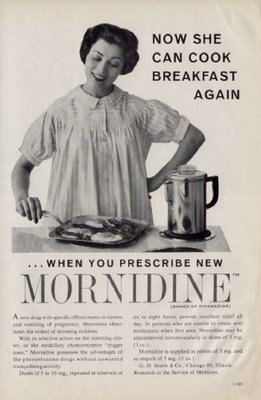
I've also put a couple of others below.



Tuesday, September 12, 2006
The Queen and I

This website demonstrates what people with too much time on their hands get up to (other than write a blog!). They took photos of themselves and £20 notes.
Sunday, September 10, 2006
News the Media Ignored
Project Censored has released its top 25 stories of 2006 that have been ignored by the mainstream media.
Some of my favourites include:
Some of my favourites include:
- Halliburton charged with selling nuclear weapons to Iran
- Bottled Water: A Global Environmental Problem
- US troops torture detainees to death in Afghanistan and Iraq
Saturday, September 09, 2006
Sunset
Friday, September 08, 2006
My London Flat
In June, I started renting a flat in Poplar with my friend S.
Poplar is slightly north of the Isle of Dogs which is a business district to the east of central London. In 1982 the Isle of Dogs Enterprise Zone was created which gave incentives to business to invest and develop in the area. Canary Wharf, on the Isle of Dogs, has some of the best skyscrapers in London. I'm lucky enough to have a balcony that looks out at Canary Wharf.
In the 1930s, George Lansbury and fellow council members were arrested for using the council rates to feed starving people.
Poplar and the Isle of Dogs were targeted by the Luftwaffe during the war because of their important docks and warehouses.
The post-war reconstruction of Poplar saw investments in affordable housing. In the 1960s, the docks began to close which led to unemployment and the abandoning of warehouses, some of which still stand derelict.
Poplar has seen the best and worst of British Socialism. Many dreamt of providing low cost housing through higher density tower estates. The skyline is dotted with 60s tower blocks next to decrepid warehouses. Some of these tower blocks are notorious with the authorities. Most nights we are able to hear police sirens and occasionally a helicopter. After all, east London has a long history of crime, organised and disorganised.
Poplar is in one of the most deprived boroughs in London, Tower Hamlets. Most of the people that I bump into while walking to the shops or station seem to be migrants or the occasional white trash. There are a scattering of pubs in the area but I haven't been to any of them yet as they all look like you may catch some nasty disease by crossing over the threshold.
Poplar is slightly north of the Isle of Dogs which is a business district to the east of central London. In 1982 the Isle of Dogs Enterprise Zone was created which gave incentives to business to invest and develop in the area. Canary Wharf, on the Isle of Dogs, has some of the best skyscrapers in London. I'm lucky enough to have a balcony that looks out at Canary Wharf.
In the 1930s, George Lansbury and fellow council members were arrested for using the council rates to feed starving people.
Poplar and the Isle of Dogs were targeted by the Luftwaffe during the war because of their important docks and warehouses.
The post-war reconstruction of Poplar saw investments in affordable housing. In the 1960s, the docks began to close which led to unemployment and the abandoning of warehouses, some of which still stand derelict.
Poplar has seen the best and worst of British Socialism. Many dreamt of providing low cost housing through higher density tower estates. The skyline is dotted with 60s tower blocks next to decrepid warehouses. Some of these tower blocks are notorious with the authorities. Most nights we are able to hear police sirens and occasionally a helicopter. After all, east London has a long history of crime, organised and disorganised.
Poplar is in one of the most deprived boroughs in London, Tower Hamlets. Most of the people that I bump into while walking to the shops or station seem to be migrants or the occasional white trash. There are a scattering of pubs in the area but I haven't been to any of them yet as they all look like you may catch some nasty disease by crossing over the threshold.
Tuesday, September 05, 2006
Casablanca
Marrakech
Marrakech was definitely the highlight of Morocco. We stayed about 200m from the big square which is surrounded by restaurants with terraced roofs, perfect for viewing all the activity. In the centre of the square there are rows and rows of orange juice sellers. If you walk anywhere near the juice stalls they all go crazy, calling to you in a variety of languages. This became quite tiresome after a while and we ended up going to the stalls that weren't putting on a song and dance. At three dirham a glass (about 20p) the orange juice was almost always great and I took to buying two litre bottles of freshly squeezed juice.
In the evening, the square is filled with mobile restaurants and portable seating. Moroccans are very keen on their shish-kebab and the smoke from these barbecues fills the square with a dense smog. Around the bbq's are crowds of people watching musicians, snake charmers, boxers and storytellers. There are big umbrellas scattered around the square, under which henna tattoo artists perform and sages sell ointments and balms, all illuminated by their own bare gaslights.
Moroccans don't ever seem to sleep. The partying in the square continues past midnight and well into the early hours of the morning.
In the evening, the square is filled with mobile restaurants and portable seating. Moroccans are very keen on their shish-kebab and the smoke from these barbecues fills the square with a dense smog. Around the bbq's are crowds of people watching musicians, snake charmers, boxers and storytellers. There are big umbrellas scattered around the square, under which henna tattoo artists perform and sages sell ointments and balms, all illuminated by their own bare gaslights.
Moroccans don't ever seem to sleep. The partying in the square continues past midnight and well into the early hours of the morning.
Monday, September 04, 2006
Colin Thiele Dies
I am sorry to report that Colin Thiele, Australian author, has died at the age of 85.
A statement on the Eudunda website indicates that Thiele may have died from complications of heart failure.
Many of Thiele's novels, including Storm Boy and Sun on the Stubble, have become an integral part of the canon of Australian children's literature.
A statement on the Eudunda website indicates that Thiele may have died from complications of heart failure.
Many of Thiele's novels, including Storm Boy and Sun on the Stubble, have become an integral part of the canon of Australian children's literature.
Sunday, September 03, 2006
Marrakech
Saturday, September 02, 2006
Marrakech
Friday, September 01, 2006
The Road to Marrakech
We decided to go to Marrakech after seeing cheap flights advertised on the internet. We had planned to take a holiday and were considering Turkey, Spain, Cuba and Morocco. Initially, our plans were to fly to Morocco and then make our way to Spain, catching the ferry to Europe from Tangiers. Ultimately, this never occured as there didn't seem to be enough time to get over to Spain and enjoy it. Also, for my friend S. the lure of a few days to recover before starting work proved too much. Personally, I was getting tired of being hassled in the way that all tourists are when they go to a country like Morocco.
We arrived at Marrakesh airport late in the evening and were able to quickly find a taxi driver who would take us to our hotel. We ended up paying 150 dirham (£9.11 or AU$22.6) to the driver who left us at the opening of the massive Place Jemaa El Fna square (see my photos) and told us that our hotel was to the right. We now know that 150 dirham is a ridiculous price to pay to get from the airport to the square. We then had to find someone who knew where our hotel was and take us there. This was all for a price and for a reason.
In Marrakesh, the taxi drivers have a sort of agreement with the locals around the Jemaa El Fna. They don't take their passengers directly to their hotel so that the locals can get tips from the tourists when they are lost and getting desparate. When we returned to Marrakech at the end our trip and hired a taxi from the train station there were heated discussions between our driver and the locals when they saw that he was going to take us right to our hotel, as we had asked him, rather than dropping us in its vague vicinity.
The hotel we stayed was Hotel Sherazade which is named after the fictional storyteller of the Book of the One Thousand and One Nights (see the wiki link). I read one of the versions of the collection of medieval stories during the holiday. Sherazade was stunningly decorated in a Moroccan style with mosaic fountains, fine carpets and some interesting Moroccan antiquities. We were told that they didn't have a room for us in the hotel but they could put us in their guesthouse until a room was available at the hotel.
We were led apprehensively down some winding side streets until we arrived at a solid wooden door. The guesthouse exceeded our expections. Built in the riad style, it had a courtyard at its centre and rooms around it up to a third floor terrace furnished with couches, deckchairs and ferns. Most importantly, it had two clean comfortable beds and a clean bathroom. The guesthouse also had a double bedroom which was occupied by a nice French couple that we spent some time with.
The only problem with Sherazade was that they kept moving us to different rooms. In the seven days that we were there (four nights the first time then three nights before flying home) we stayed in four different rooms. All of these were lovely and clean and we even had an airconditioner for the last two nights. That said, it was a charming place to stay in with an excellent atmosphere and was very close to all of the touristy parts of Marrakech.
We arrived at Marrakesh airport late in the evening and were able to quickly find a taxi driver who would take us to our hotel. We ended up paying 150 dirham (£9.11 or AU$22.6) to the driver who left us at the opening of the massive Place Jemaa El Fna square (see my photos) and told us that our hotel was to the right. We now know that 150 dirham is a ridiculous price to pay to get from the airport to the square. We then had to find someone who knew where our hotel was and take us there. This was all for a price and for a reason.
In Marrakesh, the taxi drivers have a sort of agreement with the locals around the Jemaa El Fna. They don't take their passengers directly to their hotel so that the locals can get tips from the tourists when they are lost and getting desparate. When we returned to Marrakech at the end our trip and hired a taxi from the train station there were heated discussions between our driver and the locals when they saw that he was going to take us right to our hotel, as we had asked him, rather than dropping us in its vague vicinity.
The hotel we stayed was Hotel Sherazade which is named after the fictional storyteller of the Book of the One Thousand and One Nights (see the wiki link). I read one of the versions of the collection of medieval stories during the holiday. Sherazade was stunningly decorated in a Moroccan style with mosaic fountains, fine carpets and some interesting Moroccan antiquities. We were told that they didn't have a room for us in the hotel but they could put us in their guesthouse until a room was available at the hotel.
We were led apprehensively down some winding side streets until we arrived at a solid wooden door. The guesthouse exceeded our expections. Built in the riad style, it had a courtyard at its centre and rooms around it up to a third floor terrace furnished with couches, deckchairs and ferns. Most importantly, it had two clean comfortable beds and a clean bathroom. The guesthouse also had a double bedroom which was occupied by a nice French couple that we spent some time with.
The only problem with Sherazade was that they kept moving us to different rooms. In the seven days that we were there (four nights the first time then three nights before flying home) we stayed in four different rooms. All of these were lovely and clean and we even had an airconditioner for the last two nights. That said, it was a charming place to stay in with an excellent atmosphere and was very close to all of the touristy parts of Marrakech.













